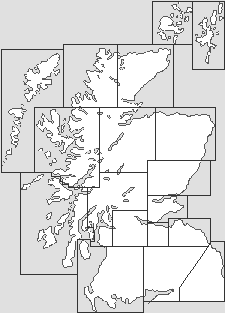 Clydesdale Bank in High Street |
Dundee is Scotland's fourth-largest city and lies on the north bank of the Tay estuary. A city with an ancient history, Dundee has had to rebuild and reinvent itself three times in the last 350 years. It saw in the third millennium in the midst of its most recent period of regeneration, and with a confidence not felt since the end of the 1800s.
Dundee's origins seem rather hazy, but by 1180 a town was well established on the north bank of the Tay here, and in the 1200s a small harbour was built. In 1239 a school was established in Dundee, with an early pupil being William Wallace. Wallace returned in 1297 to capture Dundee Castle, built on Black Rock, just to the west of the end of the modern Tay Road Bridge. The castle was repaired by Edward I, only to be completely destroyed by Robert the Bruce in 1312.
The 1300s and 1400s saw the steady growth of Dundee, fuelled largely by trade with Baltic ports. Town walls were built in 1545, but they did little to protect Dundee from the English fleet, who bombarded the town in 1547, destroying much of it. The town suffered again in September 1644 when the Marquis of Montrose and his Royalist forces besieged it.
Worse followed during the Civil War. General Monck, commanding Cromwell's forces in Scotland, captured Dundee on 1 September 1651, and his troops pillaged the town, killing up to 2,000 of Dundee's 12,000 inhabitants. Most of Dundee was destroyed in the process, as were 60 of the ships owned by the town's merchants.
It took a century for Dundee to rebuild and recover, and its population in 1755 was little more than it had been in 1651. Meanwhile it was common to see buildings in Dundee in which gable ends and stair towers from destroyed buildings projected well above the poorly rebuilt structures attached to them. The second half of the 1700s saw the city start to grow again, and the population more than doubled as imported flax started to fuel a linen industry. Meanwhile the harbour was improved, and four whaling ships began to operate from Dundee.
The city is known for being built on "Jute, Jam and Journalism". 1797 saw James Keiller & Son set up a jam factory in Dundee, while in 1801 the Dundee, Perth and Cupar Advertiser was established.
By 1835 Dundee had 36 steam powered flax spinning mills, employing a significant proportion of the 40,000 population. Meanwhile life expectancy in this heavily polluted city had shrunk to 32 years, just two-thirds of the average in Scotland at the time. 1835 also saw the first imports of jute from India, which then started to replace European flax for carpet backing and for sacks: important in a world in which almost everything was carried in sacks. Railways and trams arrived in the mid 1800s, and by 1860 Dundee was producing vast quantities of linen for sailcloth and jute for sacks. In that year the textile industry employed over 35,000 people out of a total population of just over 90,000.
By 1870, Dundee was a chaotic and squalid city that had grown to no central plan. Its second reinvention came with the 1871 City Improvement Act, which swept away most of what had gone before and replaced it with an imposing Victorian city centre, much of which remains on view today. 1878 saw the building of the Tay Rail Bridge, which collapsed with the loss of 75 lives the following year and was replaced in 1887. And by 1870s Dundee was the main British whaling port, being home to 10 steam whalers.
Jute went into a long decline from 1914, mostly because it could be processed more cheaply in India. Only one jute spinning mill survived in the city until the end of the 1900s. Meanwhile a shipbuilding industry that had produced, amongst many others, the RRS Discovery, finally came to an end in 1961. In the same year the steamer service from Dundee to London ceased.
Dundee's third regeneration probably began in the 1960s, with the completion of the Tay Road bridge in 1966 and the opening to the public in 1968 of HMS Unicorn, the oldest British built warship still afloat. And although the 1980s saw the final demise of jam and marmalade manufacturing in the city, they also saw the return of Scott of the Antarctic's ship, RRS Discovery, to the city of its birth. And also on the bright side, D.C. Thomson has remained in the city as a force in newspaper and magazine publishing. The city also has two universityies, the University of Dundee and the University of Abertay.
Today's Dundee has a great deal to offer the visitor. The city centre has an excellent range of shops and some fine buildings. And the city's past is celebrated in a number of ways. These include Discovery Point, where RRS Discovery is on view, and the Verdant Works, one of Dundee's best know jute mills recreated to reflect the everyday experience of so many past Dundonians.
 City Square |

|
|
|
Visitor InformationView Location on MapWhat3Words Location: ///valley.audit.rate |
 More Traditional Shops |
 Desperate Dan |
 The Steeple Church |
 McManus Galleries |
 Claypotts Castle |
 The Sheriff Court |






